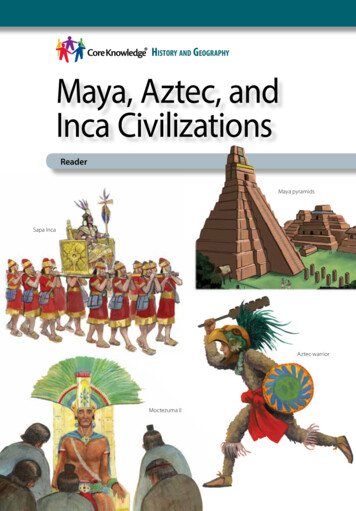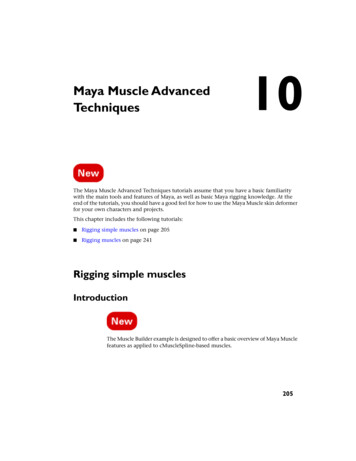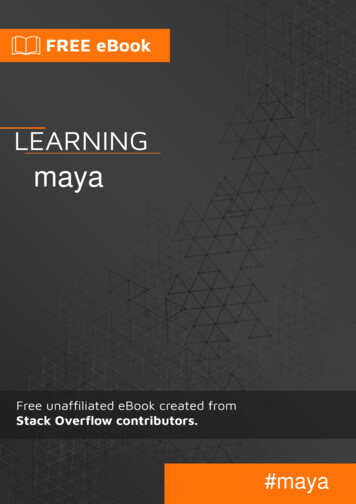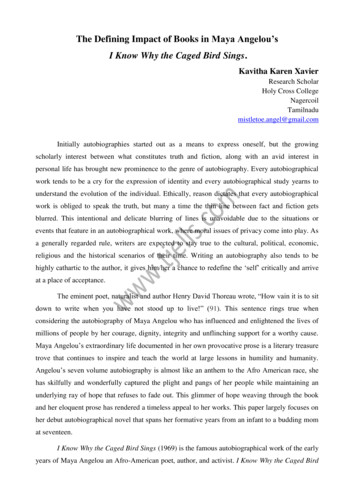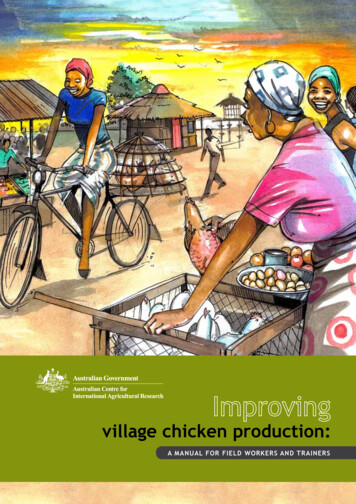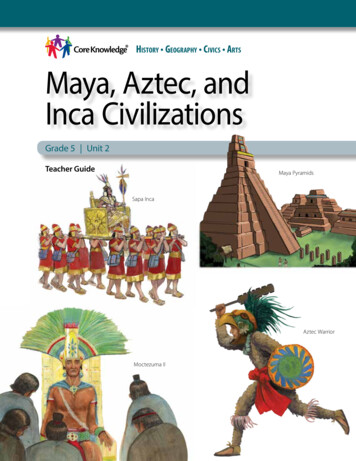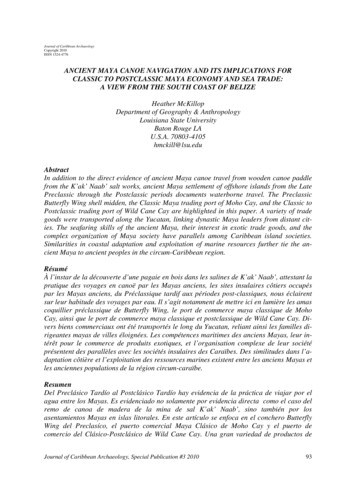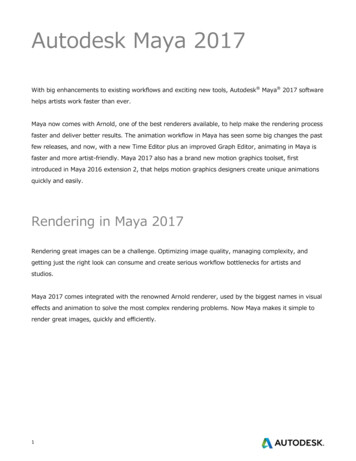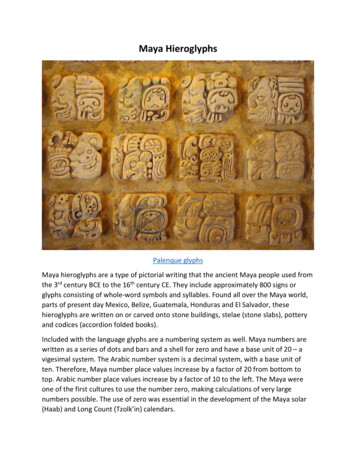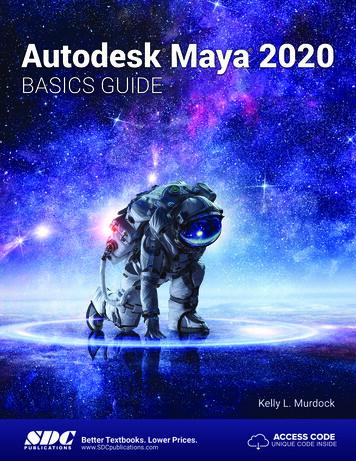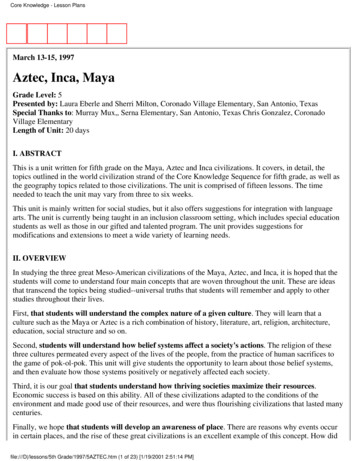
Transcription
Core Knowledge - Lesson PlansMarch 13-15, 1997Aztec, Inca, MayaGrade Level: 5Presented by: Laura Eberle and Sherri Milton, Coronado Village Elementary, San Antonio, TexasSpecial Thanks to: Murray Mux,, Serna Elementary, San Antonio, Texas Chris Gonzalez, CoronadoVillage ElementaryLength of Unit: 20 daysI. ABSTRACTThis is a unit written for fifth grade on the Maya, Aztec and Inca civilizations. It covers, in detail, thetopics outlined in the world civilization strand of the Core Knowledge Sequence for fifth grade, as well asthe geography topics related to those civilizations. The unit is comprised of fifteen lessons. The timeneeded to teach the unit may vary from three to six weeks.This unit is mainly written for social studies, but it also offers suggestions for integration with languagearts. The unit is currently being taught in an inclusion classroom setting, which includes special educationstudents as well as those in our gifted and talented program. The unit provides suggestions formodifications and extensions to meet a wide variety of learning needs.II. OVERVIEWIn studying the three great Meso-American civilizations of the Maya, Aztec, and Inca, it is hoped that thestudents will come to understand four main concepts that are woven throughout the unit. These are ideasthat transcend the topics being studied--universal truths that students will remember and apply to otherstudies throughout their lives.First, that students will understand the complex nature of a given culture. They will learn that aculture such as the Maya or Aztec is a rich combination of history, literature, art, religion, architecture,education, social structure and so on.Second, students will understand how belief systems affect a society's actions. The religion of thesethree cultures permeated every aspect of the lives of the people, from the practice of human sacrifices tothe game of pok-ol-pok. This unit will give students the opportunity to learn about those belief systems,and then evaluate how those systems positively or negatively affected each society.Third, it is our goal that students understand how thriving societies maximize their resources.Economic success is based on this ability. All of these civilizations adapted to the conditions of theenvironment and made good use of their resources, and were thus flourishing civilizations that lasted manycenturies.Finally, we hope that students will develop an awareness of place. There are reasons why events occurin certain places, and the rise of these great civilizations is an excellent example of this concept. How didfile:///D /lessons/5th Grade/1997/5AZTEC.htm (1 of 23) [1/19/2001 2:51:14 PM]
Core Knowledge - Lesson Plansthe Andes Mountains influence the society of the Inca? What was the result of the Aztec nation being builton a swamp? These questions will help students begin to think about the importance of geography.Each lesson in this unit will touch on one or more of these key concepts. In addition, every lesson targets aspecific skill objective that students should meet. Examples of skills that are taught include summarizing,comparing and contrasting, map skills, research skills, descriptive writing, and so on.The specific content taught in this unit is based on the Core Knowledge sequence for fifth grade in theworld civilization strand. In some cases, that content has been elaborated upon to maintain fluidity andheighten student involvement. The unit is comprised of the following fifteen lessons:Lesson One: Introduction to the MayaLesson Two: Maya Social StructureLesson Three: Maya Economic SystemLesson Four: Maya Daily LifeLesson Five: The Maya MysteryLesson Six: Origins of the AztecLesson Seven: The City of TenochtitlanLesson Eight: Aztec Religion and Warrior CultureLesson Nine: Aztec Social Classes and Daily LifeLesson Ten: Wrap-up on the AztecLesson Eleven: Introduction to the IncaLesson Twelve: Origins of the IncaLesson Thirteen: Incan Agriculture and FoodLesson Fourteen: Incan Social StructureLesson Fifteen: Incan Roads and BridgesIII. BACKGROUND KNOWLEDGEAs any teacher knows, it is difficult to teach content about which you know little or nothing. In doingresearch for this unit, much preparation time was devoted to reading about these fascinating cultures.There are many excellent books on the Aztec, Inca and Maya. No single source can answer every questiona teacher might have in teaching this unit, but there are two we found to be invaluable. They are:Mayan, Incan & Aztec Civilizations. (See below). This book is great for a little bit of information on justabout any topic related to all three civilizations. For example, some of the topics on the Maya includereligion, cities, writing, mathematics and astronomy, arts and crafts, agriculture, and trade. The book waswritten for high school teachers to use in the classroom. It is a great teacher reference, but also hascorresponding activities on each topic that students can complete.file:///D /lessons/5th Grade/1997/5AZTEC.htm (2 of 23) [1/19/2001 2:51:14 PM]
Core Knowledge - Lesson PlansAztec, Inca & Maya Eyewitness Books. (See below) This book is good because it provides an overview ofmany different topics which are taught in this unit. It also includes many photographs and illustrations ofartifacts from all three cultures.IV. RESOURCESThis unit made use of many resources, both for teacher information/ideas and for student reading. Whilemany of these are interchangeable, in order to teach this unit as it is written there are several resources thatare critical. They are as follows:Teacher ResourcesBaquedano, Elizabeth. Aztec, Inca & Maya Eyewitness Books. New York: Alfred A. Knopf, Inc., 1993.ISBN 0-679-83883-XHakim, Joy. The First Americans. (History of U.S. series). New York: Oxford University Press., 1993.ISBN 0-19-507746-63. Kramme, Michael. Mayan, Incan, & Aztec Civilizations. USA: Mark Twain Media Carson-DellosaPublishing Company, Inc. 1996. (CD-1886)Matthies, Susanna. Egyptians, Maya, Minoans. Santa Barbara, CA: The Learning Works, Inc., 1986. ISBN0-88160-122-5Nicholson, Robert and Claire Watts. The Aztecs. New York: Chelsea House Publishers, 1994. ISBN0-7910-2725-2Nicholson, Robert. The Maya. New York: Chelsea House Publishers, 1994.ISBN 0-7910-2729-5Strohl, Mary and Susan Schneck. Mayas, Aztecs, Incas: Cooperative Learning Activities. New York:Scholastic Professional Books, 1994. ISBN 0-59049504-6.B. Student ResourcesThe Maya Kids Discover Magazine. New York: KIDS DISCOVER, 1994. ISSN 1054-2868McKissack, Patricia. The Aztec. Chicago: Childrens Press, 1985. ISBN 0-516-41936-6McKissack, Patricia. The Inca. Chicago: Childrens Press, 1985. ISBN 0-516-41268-X(We had class sets of these and used them for several lessons.)Other Resources found later1. Bartok, Mira and Christine Ronan. Ancient Mexico (Stencils). USA: GoodYear Books, 1993. ISBN0-673-36055-52. *Bartok, Mira and Christine Ronan. The Incas and Their Ancestors (Stencils). USA: Good Year Books,1994. ISBN 0-673-36156-Xfile:///D /lessons/5th Grade/1997/5AZTEC.htm (3 of 23) [1/19/2001 2:51:15 PM]
Core Knowledge - Lesson Plans3. Green, John. Life in Ancient Mexico Coloring Book. New York: Dover Publications, Inc., 1991. ISBN0-486-26705-94. Jacobs, William Jay. Pizarro: Conqueror of Peru. New York: Franklin Watts, 1994.ISBN 0-531-15725-35. * Larson, Linda. Thematic Unit Mayans, Aztecs and Incas. Huntington Beach, California,: TeacherCreated Materials, Inc., 1996. ISBN 1-55734-595-36. * Maestro, Betsy and Giulio. The Discovery of the Americas. New York: Scholastic Inc., 1991. ISBN0-590-46515-57. * National Geographic. "Lost Kingdoms of the Maya." 60 minutesFICTIONClark, Ann Nolan. Secret of the Andes. New York: Puffin Books, 1980. ISBN 0-14-030926-8 (Incachapter book)Dupre, Judith. The Mouse Bride. New York: Alfred A Knopf, Inc., 1993. ISBN 0-679-83273-4 (Maya folktale)* Greger, C. Shana. The Fifth and Final Sun. Boston: Houghton Mifflin Company, 1994. ISBN0-395-67438-7 (Aztec tale)4. Lattimore, Deborah Nourse. The Flame of Peace. Mexico: Harper-Trophy, 1987. ISBN 0-06-443272-6(Aztec tale)Mathews, Sally Schofer. The Sad Night. New York: Clarion Books, 1994.ISBN 0-395-63035-5 (account of La Noche Triste--Aztec)6. Parke, Marilyn and Sharon Panik. Quetzalcoatl--Tale of Chocolate. USA: Fearon Teacher Aids/Simonand Schuster Supplementary Education Group, 1992. ISBN 0-86653-965-47. Parke, Marilyn and Sharon Panik. Quetzalcoatl--Tale of Corn. USA: Fearon Teacher Aids/Simon andSchuster Supplementary Education Group, 1994. ISBN 0-86653-959-XParke, Marilyn and Sharon Panik. Quetzalcoatl--Tale of the Ball Game. USA: Fearon Teacher Aids/Simonand Schuster Supplementary Education Group, 1992.ISBN 0-86653-962-X9. Rhoads, Dorothy. The Corn Grows Ripe. New York: Puffin Books, 1993.ISBN 0-14-036313-0 (Maya chapter book)Wisniewski, David. Rain Player. New York: Clarion Books, 1991. ISBN 0-395- 55112-9 (Maya folk tale)V. LESSONSA. Lesson One: Introduction to the Maya (2 days)1. Objectivesfile:///D /lessons/5th Grade/1997/5AZTEC.htm (4 of 23) [1/19/2001 2:51:15 PM]
Core Knowledge - Lesson PlansStudents will distinguish between present-day and ancient Meso-America and identify the following on amap: Central America, Mexico, Guatemala, Yucatan Peninsula, Gulf of Mexico, Pacific & Atlanticoceans.b. Students will work with a partner to find information in a magazine source.2. MaterialsKids Discover magazines "The Maya" (class set)b. Discovery of the Americas, by MaestroWorld mapd. Student maps (Appendix A)Scavenger hunt worksheets (Appendix B)3. Prior KnowledgeIntroduction to the civilizations of Meso-America (1st grade)4. Key VocabularyMeso-America, civilization5. Proceduresa. Using a large world map, tell students that we are about to begin a study of three great early civilizationsthat arose in Central and South America. Remind them that the countries we see today on the map were atfirst uninhabited lands.Review how the first Americans crossed the land bridge, spread through the Americas, and eventuallybegan to settle down, farm, and develop civilizations. Read Discovery of the Americas through p. 11. Tellstudents that the Maya are the first great civilization we will be studying and show pictures of some thegreat Mayan temples and cities to arouse their interest.Locate on large map the regions, countries, and bodies of water listed above. Discuss climate andvegetation in the tropic region. Students will then label and color individual current-day maps correctly(Appendix A).(Next class period)d. Initiate study of the Maya by holding a class scavenger hunt using the Kids Discover magazine.Students will work with a partner to scour the magazine looking for answers to worksheet questions(Appendix B).Go over the answers together and chart their responses to question #10. These should focus the students'interest and provide a starting point for the rest of the unit. This would also be a good time to do a KWLchart if desired.6. ModificationsProvide a typed list of regions, countries, and bodies of water. Allow students to cut and paste list ifnecessary (for poor fine-motor skills). Plot points on the map for easy location. Provide a clear andfile:///D /lessons/5th Grade/1997/5AZTEC.htm (5 of 23) [1/19/2001 2:51:15 PM]
Core Knowledge - Lesson Plansaccurate map example.Provide magazine page numbers next to each question. Shorten assignment; target main idea information.Highlight text, identifying the important information to answer questions. Use cooperative grouping andpeer tutoring (select appropriate partners).7. EvaluationAssess student maps for accuracy and neatness. Scavenger hunt sheets may be graded if desired.B. Lesson Two: Mayan Social Structure1. Objectivea. Students will identify the four class levels of Mayan society, and describe the duties and privileges ofeach.2. MaterialsOverhead--class pyramid (Appendix C)"Complex Social Structure" from Egyptians, Maya, Minoans pp. 62-632 sheets of plain white paper and 1 sheet of stiff paper per studentThe Maya (Nicholson) or any book with pictures of peasant hutsand city temples3. Prior KnowledgeClass distinctions in the feudal society of the Middle Ages (4th grade) Class distinctions in Ancient Rome(patricians and plebeians - 3rd grade)4. Key Vocabularypyramid, social classes, priest, nobility, peasant, slave5. Proceduresa. Discuss "pyramid of power." Use school hierarchy to model: principal,vice-principal, teachers, studentsSee if students can develop a pyramid for USA (do with partner and share).Tell students that the Maya were divided into strict social classes that determined their way of life. Discusspyramid of power in Mayan civilization using overhead of Appendix C:ruler, priests, nobility: merchants, military, peasant farmers, slavesRead about each of the levels from handout "Complex Social Structure" and The Maya pp. 10-11. Showthe differences between peasant huts and the temples which the priests and nobility lived in.Activity: Students will create a Maya pyramid of power (Dinah Zike flap book--see example in AppendixCC). Each level should include an illustration and several sentences describing the duties/privileges of thatfile:///D /lessons/5th Grade/1997/5AZTEC.htm (6 of 23) [1/19/2001 2:51:15 PM]
Core Knowledge - Lesson Planslevel.6. Modificationsa. Cooperative grouping and peer tutoring (select appropriate partners).Highlight text, identifying important information. Provide outline of teacher lecture and key terms.Provide a clear and accurate example of flap book. Pre-fold and pre-label flap book if necessary. Provide atyped list of sentences describing the duties/privileges of each level for student to cut, match, paste andillustrate.7. EvaluationAssess student pyramids for accuracy and depth of information.8. Extensiona. Discuss with students which level they would want to be if they were Maya people. How do you thinkthe peasants felt? etc.*Thanks to Murray Mux at Serna Elementary in San Antonio for these great ideas!C. Lesson Three: Mayan Economic System (2 days?)1. Objectivesa. Students will describe the Mayan tribute system and identify the roles of each of the following: batab,plom, nacom, holpop, tupil, priest, lord and ruler, and peasant.b. Students will compare and contrast the economic system of the Maya to that of the United States today.2. MaterialsHandout: "Trade is Lifeblood to the Maya" (Appendix D)"Collecting Taxes" drama--1 copy per student (Appendix E)Props for drama: paper sacks, construction paper, cookiesPictures of Tulum3. Prior KnowledgeUnderstanding of the purpose and effects of taxation in colonial America(3rd grade)4. Key Vocabularya. batab, plom, nacom, holpop, tupil, priest, lord and ruler, peasant5. ProceduresShow students an American tax form. Ask if they know what it is and lead a discussion on how and whyAmericans support the government by paying taxes every year. If desired, review issues of taxation inColonialfile:///D /lessons/5th Grade/1997/5AZTEC.htm (7 of 23) [1/19/2001 2:51:15 PM]
Core Knowledge - Lesson PlansAmerica.Explain to students that all civilizations have some type of organized economic system to share goods andservices. Review from Lesson Two the Mayan pyramid of power, and brainstorm how they think theMayan system might work (point out that the Maya did not have money).c. Write the following on the board: "Trade is lifeblood to the Maya." Allow for student analysis and thenexplain that the Maya met their need for goods and services through trade instead of money. Explain thatbecause the climate was so conducive to farming, the Maya only had to work their land about 50 days outof the year. This gave them time to practice a trade as well, and time to provide services for thegovernment. Trading took place at the market in cities. Have students read "Trade is Lifeblood to theMaya" (Appendix D) and highlight all the things that were traded in the market. List these on board; eachstudent chooses one.Activity: Explain tribute system, which was comprised of a tax and work-service, with the drama"Collecting Taxes" (Appendix E). List the following roles on the board to define as the drama is read:batab, plom, lord and ruler, priest, nacom, holpop, tupil and peasant. Read the drama as a class and act itout by trading market products.6. Modificationsa. Highlight text, identifying important information. Provide outline of teacher lecture and key terms.Preview vocabulary and specific participant roles. Assist students with selecting a role (short reading part).7. Evaluation: Quick-writeProject: Maya marketplace from pp. 56-57 of Mayas Aztecs Incas (Strohl & Schneck)D. Lesson Four: Daily Life (Research - 2 days)1. Objectivesa. Students will develop an appreciation of the complex nature of the Maya culture, and how it comparesto our own.b. Students will develop research and social skills.c. Students will describe Maya clothing, fashion, recreation, food and family life.2. MaterialsArticles from Egyptians, Maya, Minoans:b. What Price Beauty (fashion) pp. 50-51The Maya Look (clothing) pp. 48-49d. Pok-a-Tok (recreation) pp. 64-65Excerpts from The Mayaf. Food (pp. 9, 24)file:///D /lessons/5th Grade/1997/5AZTEC.htm (8 of 23) [1/19/2001 2:51:15 PM]
Core Knowledge - Lesson PlansFamilies and Children (pp. 20-21)h. Note-taking sheet (Appendix F)Legal size white paper and large construction paperFilmstrip "The Maya" -- Ancient Civilizations of the Americas3. Prior Knowledgea. An understanding that different cultures have unique characteristics (all grades) 4. Proceduresa. Review from KWL chart what students want to learn.Explain that in this lesson, each group of students will become an expert on one aspect of Maya daily life.Number the categories listed above on the board. Have a member from each group roll a die; the numberrolled will determine which category that group will research.Give to each group 4 copies of the appropriate handouts. (Each student should have a copy to use.) Instructstudents that they will have the rest of the class period to read their material and come up with a way topresent that information to the rest of the class. Presentations should include some sort of visual aid, andevery member must take part in the presentation. (Students will continue work and additional researchduring project time and as homework if necessary.)(Next class period)Each group presents its information. The rest of the class should be taking notes (Appendix F) and askingquestions. Participation as presenters and as audience should be evaluated.e. Show filmstrip "The Maya" (Ancient Civilizations of the Americas) and have students add to theirnote-taking as appropriate.Activity: Students will create a flap book with information and illustrations on each category (use legalsize paper).5. Modificationsa. Preview vocabulary and specific research topics. Assist students with selecting a topic (possibly a topicwith low level reading material or a topic which is easy to research and present).b. Highlight text identifying important information from handout. Provide outline of key terms and mainidea for presentation. Provide a written outline of expectations and visual aid requirements. Provideexamples of visual aids and materials if necessary.Allow students to take notes; however, provide a clear concise copy of notes. Adjust grading requirementsas needed.Provide a clear and accurate example of flap book. Pre-fold and pre-label flap book if necessary. Provide atyped list of sentences describing the daily life of the Mayas for students to cut, match, paste and illustratefor each topic.6. EvaluationStudents may be assessed on their group work, their participation in group presentation, their participationas audience members, and on their flap books.file:///D /lessons/5th Grade/1997/5AZTEC.htm (9 of 23) [1/19/2001 2:51:15 PM]
Core Knowledge - Lesson PlansE. Lesson Five: The Maya Mystery1. Objectivea. Students will analyze existing theories of the Maya's disappearance.2. Materials"The Maya Mystery" from Egyptians, Maya, Minoans pp. 66-67b. "The Great Mayan Mystery" from M, I, & A Civilizations p. 36Construction paperd. Template for booklet (Appendix G)Video: "Lost Kingdoms of the Maya," National Geographic.3. Key Vocabularytheory, abandon, mystery4. ProceduresPresent the following scenario to students: Imagine that all of the people in Houston suddenly abandonedthe city without leaving behind any indication of where they had gone or why they had left. Why mightpeople abruptly abandon a city? Brainstorm ideas on board. (From Egyptians, Maya, Minoans)Explain that something similar happened to the Maya between AD 850 and 900. (Add to class time line.)Read "The Maya Mystery" and/or "The Great Mayan Mystery" and discuss the theories presented.c. Students will create a combination folder book to present theories of the Maya's sudden disappearanceand to state what they think happened.(Use construction paper for the cover, and template for writing on the inside--Appendix G.)To wrap up study of the Maya, fill in the "L" portion of KWL chart.e. Show National Geographic video on the Maya if time allows.5. Modificationsa. Highlight text, identifying important information from handout. Provide outline of key terms andtheories from teacher lecture and text.Provide a clear and accurate example of folder book. Pre-fold and pre-cut folder book if necessary.Provide a typed list of sentences describing the theories of the Maya's sudden disappearance. To assessstudent understanding, add other unrelated theories requiring students to cut and paste only the correcttheories. Adjust grading requirements as needed.6. EvaluationAssess folder books for accuracy and creativity, as well as for supporting their ideas.F. Lesson Six: Origins of the Aztecsfile:///D /lessons/5th Grade/1997/5AZTEC.htm (10 of 23) [1/19/2001 2:51:15 PM]
Core Knowledge - Lesson Plans1. Objectivea. Students will compare and contrast the historical and mythological accounts of the origins of the Azteccivilization.2. Materials"In Search of a Homeland" handout for students (Appendix H)b. The Aztec (McKissack), pp. 9-15Picture, overhead or example of Mexican flagd. White paper for flap books3. Prior KnowledgeRecognition of Mexico's flag (1st grade)b. Legend of Rome's origins in myth of Romulus and Remus (3rd grade)4. Key Vocabularyorigin, civilization, myth5. Proceduresa. Show students a picture of the Mexican flag. Encourage them to hypothesize about the meaning of thecactus, eagle and serpent.Using the maps from Lesson One, review where Mexico is and tell students we are now beginning ourstudy of the second great Meso-American civilization, the Aztecs. How did the Aztec civilization comeinto being?c. Draw the following chart on the board:HISTORY MYTHd. Students read "In Search of a Homeland" (Appendix H). Discuss the mythological origins of the Aztecnation. Chart information under "myth."Now have students read from The Aztec, pp. 9-15. Chart information under "History" and give studentsadditional information from other sources. Also add to "Myth" side. Note important dates and add them toclass time line.f. Compare and contrast the two versions of the origins of the Aztec civilization. Why did the Aztecschoose to believe the myth instead of the facts? Can you think of other civilizations who also did this? (theRomans--myth of Romulus and Remus) Why do you think these symbols still appear on the Mexican flagtoday?Activity: Students will create a two-part flap book that explains the two accounts of the rise of the Azteccivilization.6. Modificationsfile:///D /lessons/5th Grade/1997/5AZTEC.htm (11 of 23) [1/19/2001 2:51:15 PM]
Core Knowledge - Lesson Plansa. Highlight text, identifying important information from handout. Provide outline of key terms andinformation about the myth and the history from teacher lecture and text.Provide a clear and accurate example of two-part flap book. Pre-fold and pre-cut flap book if necessary.Provide a typed list of sentences describing both the historical and the mythological origins of the Aztecs.Require students to determine on which side of the flap book the information belongs; cut and pastecorrectly.7. EvaluationAssess flap books for accuracy and presentation.G. Lesson Seven: The City of Tenochtitlan1. Objectivesa. Students will understand how a society makes the most of its resources.b. Students will write a descriptive paragraph on the city of Tenochtitlan.c. Students will define: aqueduct, chinampa, and causeway.2. Materialsa. The First Americans p. 96The Aztecs (Nicholson & Watts) for pictures of the cityc. "Tenochtitlan: Clean!" handouts (Appendix I)Paper for student writing (Appendix J)e. Life in Ancient Mexico Coloring Book, p. 24-25 -- OPTIONAL3. Prior KnowledgeAqueducts in Roman architecture (3rd grade)Uncleanliness of cities in Europe during the Middle Ages (4th grade)4. Key Vocabularyaqueduct, causeway, chinampa5. Proceduresa. Review from Lesson Six the geographical area of Mexico where the Aztec civilization arose. Tellstudents that the Aztec people called their land Anahuac, which meant the land on the edge of the waters.Here they built an incredible city called Tenochtitlan.Ask student to close their eyes as you read an account, written by a Spaniard, of what Tenochtitlan waslike. Read "Place of the Prickly Pear Cactus Fruit" from The First Americans. Ask students to share theirmental images of the city. Show them any pictures you can find of the city.c. Have students read "Tenochtitlan: Clean!" (Appendix I). Define and discuss the following words on achart: aqueducts, chinampas, causeways. How did the Aztecs make the most of their land?file:///D /lessons/5th Grade/1997/5AZTEC.htm (12 of 23) [1/19/2001 2:51:15 PM]
Core Knowledge - Lesson Plansd. Activity: Using Appendix J writing paper, students will write a descriptive paragraph which describesthe city. The paragraph should include the words discussed in Appendix C. Label parts of picture.6. ModificationsHighlight text, identifying important information from handout. Provide outline of key terms and mainidea from text and lecture.Provide a typed list of key terms to cut, paste and label the picture. Prepare a paragraph describingTenochtitlan, including facts and relevant information as well as incorrect sentences; require students todraw a linethrough a determined number of incorrect sentences.7. EvaluationAssess pictures and paragraphs for depth of description and neatness of labeling and coloring.H. Lesson Eight: Aztec Religion and Warrior Culture1. Objectivea. Students will understand how the belief system of a society affects its actions.2. MaterialsExcerpt from Mayan, Incan and Aztec Civilizations: "Aztec Religion" pp. 86-87b. The Aztecs (Nicholson & Watts), pp. 8-13Brown paper grocery sacks for codicesd. Teacher-made charts of the gods (not necessary but handy)The Fifth and Final Sun (Greger) -- OPTIONAL3. Prior Knowledgea. World religions (1st grade)4. Key Vocabulary(names of gods)5. Proceduresa. On the board, write " the Aztecs" and underneath it make a large number one: The Aztecs#1Tell students that for the Aztecs, there was one thing that was the number one concern; one thing thatgoverned every day of their lives; one thing that was the most important to all of the people, nobility andcommoners alike. What was it? (Allow for ideas) Then write underneath the #1 : PLEASING THE GODS.b. Who were the Aztec gods? List on chart and discuss:file:///D /lessons/5th Grade/1997/5AZTEC.htm (13 of 23) [1/19/2001 2:51:15 PM]
Core Knowledge - Lesson PlansHuitzilopochtli:patron god of the Aztecs"blue hummingbird"god of war, god of the sunsacrifices made to keep him aliveneeded blood to survive2) Quetzalcoatl:god of learning, hope and healing"quetzal" bird; "coatl" snakealso god of the wind (Ehecatl)leaders wore feathers of quetzal birdfriendly faceinventor of writing and the calendarin legend, supposed to come back to decide the fate of the AztecsTlaloc:god of rainsymbolized by double-headed serpentchildren drowned as sacrifice to him in drought4) Tezcatlipoca:supreme god and patron of rulersLord of the Nightthe first sunChalchihuitlicue:goddess of water from springs and seasTlaloc's wife"Our Lady of the Turquoise Skirt"Read together "Aztec Religion" and excerpts from The Aztecs and discuss their beliefs about the sun godand how it affected their culture. Talk about the 'flowery wars' fought in order to get victims for sacrifice.How would the surrounding city-states feel about these wars? (this will be important later, because thosecities became allies of Cortes to fight against the Aztecs.) Discuss how it was an honor to be sacrificed!(OPTIONAL) Obtain a copy of The Fifth and Final Sun by C. Shana Greger and read it to the class. Thisfile:///D /lessons/5th Grade/1997/5AZTEC.htm (14 of 23) [1/19/2001 2:51:15 PM]
Core Knowledge - Lesson Plansbook tells the myth of the sun's origin and includes many of the deities introduced in this lesson.Activity: Students create codices out of paper bags (see directions inMayas Aztecs Incas p. 36 Strohl and Schneck). Students cut a longstrip of paper bag and fold it back and forth like a fan. Have them thenuse one page for each god, to illustrate and identify key attributes.6. Modificationsa. Highlight text, identifying important information from handout.Provide outline of key terms and main idea from text and lecture.Provide list of gods and their attributes for students to cut, paste and illustrate.7. EvaluationAssess codices for neatness and accuracy.b. Project: Make a serpent mosaic (Cooperative Learning Activities book, Strohl)Extension: Moral analysis--Does the practice of human sacrifice make the Aztecs "bad" people? Discusstheir system of law and order, which was not cruel or unfair. Did they not know any better?I. Lesson Nine: Social Classes and Daily Life (Research - 2 days)1. Objectives:a. Students will develop an appreciation of the complex nature of the Aztec culture,
Aztec, Inca, Maya Grade Level: 5 Presented by: Laura Eberle and Sherri Milton, Coronado Village Elementary, San Antonio, Texas Special Thanks to: Murray Mux,, Serna Elementary, San Antonio, Texas Chris Gonzalez, Coronado Village Elementary Length of Unit: 20 days I. ABSTRACT This is a unit written for fif
